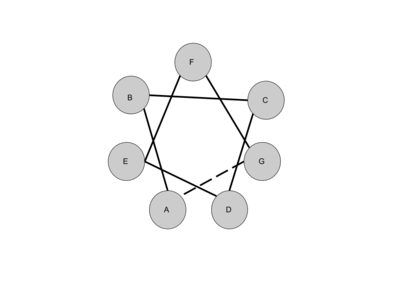Design
The design of this protein occurred in two different phases; the initial design of the alpha bundle helix and then the installation of the cysteine hydrolase functional triad into that bundle.[1]
α-Barrel Design
The design of the coiled coiled heptamer occurred previously, in which a computational and geometrical framework was created. This framework was inspired by classical α-helical bundles that use a heptad repeat, generally written as abcdefg, with the a and d positions occupied by hydrophobic amino acids. This gives rise to hydrophobic seams which can give rise to aggregation and coiled coils which are generally further stabilized by charged interactions at the g and e positions. However in an α-barrel each helix acts with an independent hydrophobic seam with its neighbor. The resulting possible interactions from this interface can be broken down into three types of which type II is utilized for the CC-Heptamer in which a, d, e, and g are all hydrophobic. These principles were used to create CCBuilder (of which their is a newer version CCBuilder 2.0), an in silico modeler of α-helical coiled coils and α-barrels. [2]

Visual representation of the heptad repeats Installation of Cysteine Hydrolase
Previous research had been done on a CC-Hexamer in which it was shown to be mutable at L24[3]. Furthermore it was shown that a cysteine could be installed at this position and could be modified by alkylation, signaling the potential for enzyme design[4]. Naturally then a Cys hydrolase was chosen to be installed in the CC-Heptamer. Individual helices of the heptamer are made of four heptad repeats leading to 12 different a-d-a or d-a-d contiguous systems in which Glu-His-Cys or Cys-His-Glu could be respectively installed. However these possibilities were reduced when fraying affects were taken into account at the edges and for initial mutations only the third heptad was considered. The initial mutations were a test of the stability of the CC-Heptamer and were and mutants. Upon X-ray crystallization the Cys were not sulfide bonding and the His were in a hydrogen bonding ring, and the structure was stable. Then to verify orientation the and His-Cys-Ile mutants were created with the latter predicting to form heptamers and the former only hexamers. This indeed proved the case and finally the mutant was created and shown to be stable.[1]
Function
The function of these de-novo enzymes were tested by a colorimetric p-nitrophenyl acetate assay. The de-novo designed enzyme had activity 250 times over baseline, while a short unstructured peptide with those amino acids and a single helix containing the same arrangement of amino acids had a catalytic rate just barely over baseline. Mutating any of the residues other than cysteine to Ile also virtually abolished catalytic activity, and the Ile-His-Glu was still not as active. Finally, in order to increase catalytic rates a This lead to over all better kinetic rates but less efficient burst rate mechanisms. An effect of the more flexible but less acidic hCys compared to Cys. It was also seen in crystal structures that the Cys pointed away from the imidazole ring, and was therefore thought to have to rotate to be catalytically active. In order to test this the which would keep the thiol away from the His and therefore virtually eliminated activity over baseline. Analysis on the kinematic rates demonstrated a ping-pong like mechanism. However, a non linear burst phase due to the difficulty of seven substrates entering and positioning correctly at once was shown.[1]
Relevance
The relevance of this structure is less, the development of a particular hydrolase, and more the wider ranging implications. It demonstrates a systematic way of robust enzyme design that can potentially be more easily used for new enzymatic pathways. As well due to it's structural stability and ease of engineering the potential to use it at non-physiological conditions. Thus opening up a variety of new possibilities of de-novo enzyme design, as well as allowing for a new testing ground for insights into enzymatic theory.

